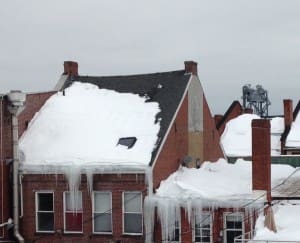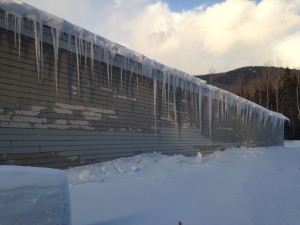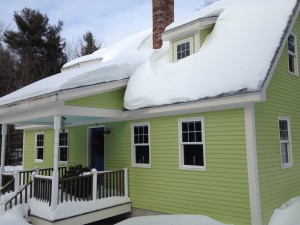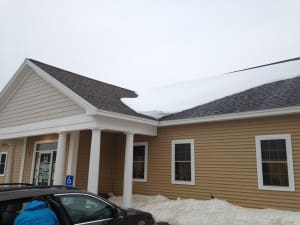Article submitted by Affiliate member, Tony Fallon, Tony Fallon Architecture
Ice Dams and Icicles are on all our minds and many of our roofs with this long, snowy Winter. A family friend asked me to come in to look at something that has never happened at their house since they bought it in 1972, major leaks from ice dams. All of a sudden our safe home can turn into a construction site with clothing, furnishings, and finishes displaced and sometimes needing to be replaced. When Ice Dams set in the fix is not easy or quick. Icicles are pretty to look at but dangerous to be under. Also they mean you are having ice dam problems too.
I offer here a long term solution that saves on your heating fuel bill and, if done properly, reduces to insignificance or eliminates ice dams and icicles. The solution is to achieve a Uniform Roof Temperature by increasing insulation sufficiently.
You will not find ice dams nor large icicles on an unheated building like a barn which has a uniform roof temperature. Our goal is to have the snow on a roof to only change to water if it is going to stay water until it hits the ground. Ice dams are caused when snow changes to water on an insufficiently insulated roof and then changes to ice at the lower edge of the roof near the cold eaves. Ice dams work back up under roof shingles which causes the leaks.
Stating all of this another way, we want water to start to melt off a roof on a 40 degree day when it is likely to make it all the way to the ground and not on a 20 degree day when it is likely to get stuck at the cold eaves. And from yet another perspective, we want the outside temperature to melt the snow on a roof which gives the water the best chance of making it all the way to the ground in one shot. We do not want the snow to melt from the inside temperature which makes it likely to get stuck at, and help build, ice dams and icicles at the cold eaves that have no interior heat beneath them.
In the Northeastern United States, I recommend R.60 for the Roof Insulation. We often don’t get there, but I recommend getting as far towards that as you can. I recommend a combination of Dense Pack Cellulose from a manufacturer like National Fiber between rafters and an exterior foam system like that of Atlas ACFoam CrossVent Insulation Board. You can also build this exterior foam up with Atlas ACFoam-II Polyiso Roof Insulation and buying the cross vent shims separately or making up your own out of wood. I like making up the panels in the field after some factory made CrossVent panels arrived with a bow to them on a recent project.
Below are pictures of my home which used to have tons of ice dams and icicles with the standard fare of R.38 fiberglass insulation in the Second Floor Ceiling and R.30 Fiberglass in the 2×10 sloped ceilings. We removed all fiberglass and switched to 18 inches of cellulose at the Second Floor Ceiling for a R.68.4 and R.35 at the sloped ceiling. Although I didn’t get the ideal insulation in the area of the sloped ceiling, it still worked. Cellulose performs better than Fiberglass at cold temperatures. There are some reports that show cellulose performing much better than fiberglass and that is certainly what I have found in my own home and many of my projects over 20 plus years.
It is not just wood framed buildings that have ice dam and icicle problems. Metal buildings can suffer from this too. There is a metal building that I am doing some changes to where the tenants are very worn out with all of the buckets and other creative things they have come up with to catch the cascading water around the edge of the building. A simple solution for this is to use an exterior spray foam roof placed on top of the metal building metal panel roof. After placing the spray foam on the metal roof, it is coated with a sealer that will bring it to a roofing grade finish. This does cost some bucks to do, but the good news is that 20 years from now, at the end of the roofing cycle, it is very affordable to just do a resealing versus what one would normally spend on a re-roofing. Of course the added benefits of not having leaks and paying less for heating fuel make the building much more marketable and valuable. For reference, the Superdome in New Orleans has this roofing system.
There are other things to monitor like vapor transmission, venting, and structure with increasing roof insulation to achieve a uniform roof temperature. We have to be sure that the building can hold more snow hanging around and that we don’t wind up with mold or mildew.
The net gain is simple though, eliminate ice dams, icicles, and their related leaks and save money on your fuel bill by increasing roof insulation so that you achieve a uniform roof temperature. This is a wonderful win win. Wow!




CONTACT Information:
Tony Fallon
Tony Fallon Architecture
501 Barn Door Gap
Strafford, NH 03884
tony@tonyfallon.com
603-269-3206




